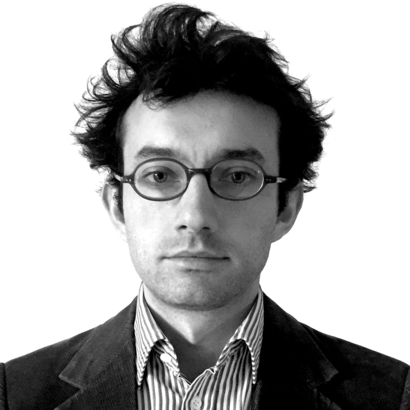Max Jacob wrote some fine poetry. He was also a capable painter who could always dash off a few charming gouache landscapes when in need of money.
But Jacob had the misfortune of being a contemporary of Picasso’s and Modigliani’s, both of whom painted his portrait, along with Guillaume Apollinaire, who name-checks his fellow author in one of his poems. Jacob’s own work is hardly forgotten and retains a small dedicated following in France. He nonetheless seems destined to continue to be defined by the more illustrious figures with whom he shared the cultural stage. Jacob is the Ringo Starr of modernist French literature.

In this new biography, Rosanna Warren mostly reiterates that view of her subject. “Jacob was not a giant,” she says in her preface. “But he was a larger force in the creation of modern French literature than has been recognized.”
The hub of that creative revolution was a former piano factory in Montmartre christened (possibly by Jacob) the Bateau Lavoir because the rackety wooden structure resembled the laundry boats moored along the Seine. Picasso took up residence there in the spring of 1904, later to be joined by Jacob and Modigliani, among other literary and artistic luminaries over the course of the decade.
19th-Century Bohemian
Like many of these figures, Jacob was a precociously gifted provincial, who had been born into a family of secular Jewish shopkeepers in the Breton town of Quimper in 1876. He first moved to Paris in 1894, initially studying to enter the colonial service while also completing a law degree. By the end of the century, he had opted instead for the bohemian life of a writer, supporting himself through odd jobs as a journalist, fortune-teller, and department-store clerk.
Jacob entered the literary scene just as the poetic innovations of Stéphane Mallarmé, who died in 1898, and his followers were hitting diminishing returns. In place of Symbolist obscurity and mystical reveries, Jacob, along with Apollinaire and André Salmon, embraced wordplay, clashing tones, and the color of Parisian street life. Whereas their precursors had largely remained aloof from popular culture, the poetry of Jacob and his friends teems with jubilant allusions to the cinema, advertising posters, and pulp novels.
Jacob was already forging a new poetic path in the first decade of the 20th century, when Apollinaire and Salmon remained in thrall to Symbolist convention. He also perceived the aesthetic potential of what Warren calls “the flotsam and jetsam of public language” years before Picasso and Braque began incorporating newspapers and other textual oddments into their Cubist collages.

But, like many cultural pioneers, Jacob ultimately found himself overtaken by the artists and writers in his slipstream, who honed the insights and techniques he had developed to create work that expressed a more arresting and universal aesthetic vision. Whereas Jacob’s early poetry often seems whimsical and anecdotal, it was Apollinaire who elevated the tumult of Belle Époque Paris into a world-historical epiphany with “Zone,” his epic urban pastoral published in 1912.
Jacob perceived the aesthetic potential of “the flotsam and jetsam of public language” years before Picasso and Braque.
At first, Jacob was delighted by his friends’ growing fame. Lacking Apollinaire’s and Picasso’s physical presence and charisma, he seemed satisfied with the modest renown brought by his own work and more subtle personal charms.
But over time, Jacob’s feelings about being the junior partner became more ambivalent. Even before the First World War, as the Bateau Lavoir circle unraveled, Jacob began to clash with Picasso and bemoaned his friend’s failure to respond to his letters. He also converted to Catholicism after experiencing a series of religious visions in 1909, prompted in part, Warren suggests, by the shock of Picasso’s moving out of their shared home.
Having both avoided the fighting—Picasso as a foreign national; Jacob thanks to an earlier medical discharge—the two friends drifted further apart after the war, which ended two days after Apollinaire’s death, from influenza, in November 1918. At his funeral, Jacob is said to have remarked that he would henceforth become “the leader.” But the 1920s avant-garde had only qualified respect for Jacob, and the Surrealists ultimately launched several venomous attacks on the poet. Disenchanted with the fractious atmosphere in Paris, Jacob retreated in 1921 to a monastery near Orléans, where he would spend most of his final two decades.
Jacob juggled devotion to the church with love for a string of, in Warren’s rather understated phrase, “impossible young men.” These included the Surrealist writer and ethnographer Michel Leiris, Jean Cocteau, and the arch-scoundrel Maurice Sachs, a Jewish writer and con man who ended up working for the Gestapo before being killed in Nazi custody.

Jacob also met a dismal end, dying of pneumonia in March 1944 in the Drancy internment camp, outside Paris, two days before he was due to be deported to Auschwitz, where two of his siblings had already been murdered. Picasso notoriously declined to sign a petition for his release, organized by Cocteau. Warren initially describes that refusal as a “betrayal” but later concludes that the artist had been dissuaded from signing since doing so would have curried no favor with the Gestapo and risked triggering his expulsion to Franco’s Spain.
That nuanced assessment is typical of her immensely erudite biography, which is an invaluable resource for Jacob scholars and aficionados. Warren’s book also offers non-specialist readers a lively survey of France’s topsy-turvy cultural history from the Dreyfus affair to the Second World War.
Max McGuinness teaches French at the University of Limerick


